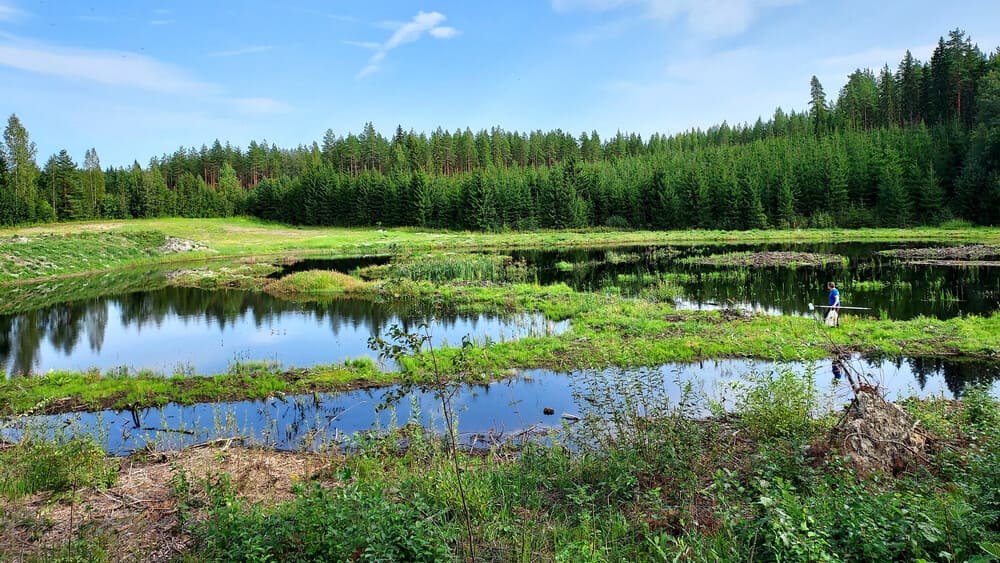Basic info
Country:
Area:
Population:
Density:
Summary:
References:
https://kvvy.fi/yhdistys/keurus/
www.ksvkv.fi/wp-content/uploads/KEURUS-hanke-esite.pdf
Kuoppamäki, K., Huuskola, R. & Laitinen, T. 2024. Toivonlammen kosteikko rakentui ei-tuotannollisten investointien avulla. Aquarius 2024–2025, pp. 28-30. Available: https://kvvy.fi/wp-content/uploads/2024/12/Aquarius-2024-2025_Toivonlammen-kosteikko.pdf
Kuoppamäki, K et al. 2022. KEURUS – Keurusselän valuma-alueen kunnostushanke. Loppuraportti 2021–2022. Nro: 6/2022. Available: https://kvvy.fi/wp-content/uploads/2023/01/KEURUS-loppuraportti.pdf
Keywords
Gallery
„This feels like the landscape of my childhood!“
Issues Addressed
The Keurusselkä catchment area faces ecological challenges that threaten the water quality of local water bodies. Without intervention, the currently good ecological state of Lake Keurusselkä is predicted to decline to satisfactory. Key issues include the load of organic carbon and humic matter, which causes the brownification and silting of water bodies accompanied by lakes becoming shallower and overgrown. This is due to extensive draining of local peatlands that has also weakened water retention capacity of catchment areas, resulting in harmful water level fluctuations. Here and there, peat production has also impacted downstream waterways. The region experiences both flooding and drought, worsened by extreme weather events due to climate change. Urban areas face stormwater management challenges, including flooding. Nutrient export from catchment areas has led to occasional harmful algal blooms. These water quality issues affect local attractions, tourism, and fishery. The KEURUS project aims to address these challenges by balancing water management needs with the area’s economic activities, recognising the critical role of clean waterways in supporting both environmental and economic sustainability.
Approaches and Solutions
The KEURUS project combines scientific knowledge with nature-based solutions to address challenges in catchment management and water protection. It integrates sustainable land use, water management, and fisheries practices into a comprehensive catchment area restoration plan. Cutting-edge technology like drone photography is being used to document the impacts of management actions on landscape change. Ecological, nature-based interventions such as rewetting dried peatlands, constructing wetlands and other solutions that retain and filter water are being used as solutions to manage catchment areas. The project develops tailored plans for agricultural, forestry, and urban areas, ensuring a holistic approach. Central to its success is strong stakeholder engagement, fostering community ownership through a cooperation network that facilitates open communication and information exchange among diverse participants.
Actors and Stakeholders
The project is run by the Water Protection Association of the River Kokemäenjoki (www.kvvy.fi/en) together with Keski-Suomen vesi ja ympäristö ry (www.k-svy.fi; “Association of water and environment of central Finland). Municipalities of Keuruu, Multia and Mänttä-Vilppula, companies on forestry (UPM Metsä, Finsilva Oyj) and peat production (Neova Group) participate in funding and collaboration. The main funding has been obtained from the National Environmental Administration. Stakeholders include local landowners, water area owners, associations, companies and other organisations.
Challenges and Opportunities
The primary challenge was the deteriorating water quality of Lake Keurusselkä and surrounding waterways in the catchment, dominated by peatlands. Elevated loads of organic carbon and humic matter cause the brownification and silting of waterways. Another problem is the occasionally very acidic (pH <5) waterways, which hampers the survival and reproduction of trout (Salmo trutta). Extensive draining and channelling for forestry have weakened the water retention capacity of the catchment, resulting in harmful water level fluctuations and occasional flooding and, on the other hand, occasional drought periods. These issues are worsened by climate change and, consequently, increasingly frequent extreme weather events and unpredictable water cycles.
The catchment area of Lake Keurusselkä has numerous peatland areas that were drained for forestry but there are many such areas that, nevertheless, cannot support tree growth. Keurus project, together with landowners and other stakeholders, aims at restoring such poorly productive forest land by converting them back to bogland. They improve water retention and act as filters that improve runoff quality. As such, this approach also implements the recently launched regulation of the European Council on nature restoration. Another restoration approach, for example, is the establishment of wetlands in agricultural lowland areas, in fields suffering from frequent wet conditions. Wetlands retain suspended solids and nutrients and, thus, improve water protection while at the same time support biodiversity and improve landscape. Additionally, soil removed from constructed wetland areas can be used to manage above fields and, thus, improve agricultural productivity.
Outcomes and Lessons Learnt
The KEURUS project has achieved outcomes by, for instance, planning and constructing wetlands and diverting runoff to dried bogs from surrounding ditched forests. This intervention decreased siltation loads in the river and enhanced both water quality and holding capacity. Following the successful implementation of pilot sites, the project secured additional funding and encouraged local landowners and other stakeholders to participate in enrolling new restoration sites. This expansion not only amplifies the project’s positive environmental impact but also fosters a collaborative approach to water management across the region.
Addressing environmental issues like local hydrology together with the quality and value of land and adjacent water bodies raises local awareness of these important, though threatened properties.
The Keurus project shows that anyone, especially landowners, can participate in protecting the environment by restoring the landscape through various nature-based solutions. This, in turn, increases the municipality’s value and attractiveness. In addition, the Keurus project enhances the region’s visibility and awareness.
Selected major projects and awards
- The Keurusselkä catchment area restoration project has received continuous funding over several years and aims at ensuring local management actions also in the future, after the Keurus project has finished.
- The pilot phase in 2021-2022 was funded by the Ministry of Agriculture and Forestry and the Ministry of the Environment from the funds for promoting water management in agricultural and forestry areas through the Central Finland ELY Centre (www.ely-keskus.fi/en/web/ely-en). In spring 2023, the follow-up project received funding until 15 June 2025 from the Ministry of the Environment’s Water Protection Enhancement Programme through the North Ostrobothnia ELY Centre’s water management programme for agriculture and forestry. Funding for yet another follow-up project for years 2025-2027 has been applied from the Ministry of the Environment (https://ym.fi/en/water-resources-and-marine-protection).





